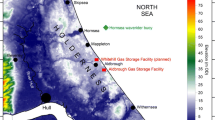Abstract
This paper, Part I in a series of two, develops a mathematical model for earthern dam breach erosion. This model constitutes an extension of the Breach Erosion of Earthfill Dams (BEED) model developed by Singh and Scarlatos (1987). Two aspects are emphasized: the evolution of the dam breach, and the subsequent flood and sediment routing. Simulation of dam breach evolution is based on hydrologic, geometric and geotechnic considerations. Einstein-Brown and Bagnold equations are utilized to compute the rate of erosion in the breached section. A water routing scheme, based on a modified version of the Muskingum method to simulate flow exchange between channel and floodplains, is used to route the resulting breach hydrograph. A sediment routing scheme based on the Muskingum method, modified to simulate deposition in floodplains, and deposition and scouring in the channel, is utilized to route the breach sediment graph. In Part II, the model is tested against historical dam failures, and an analysis is made to determine its sensitivity to various parameters.
Similar content being viewed by others
References
Brown C. B., 1950, Sediment transportation, in H. Rouse (ed.), Engineering Hydraulics, John Wiley, New York, pp. 711–768.
Chen Y. H., 1979, Water and sediment routing in rivers, in Shen (ed.), Modeling of Rivers, John Wiley, New York, pp. 10–2 to 10–97.
Chugaev, R. R., 1966, Stability analysis of earth slopes, translated by A. Baruch, Israel Program for Scientific Translations, Jerusalem, Israel.
Cristofano E. A., 1965, Method of computing erosion rate for failure of earthfill dams, USDI Bureau of Reclamation, Denver, Colorado.
Cunge J. A., 1969, On the subject of a flood propagation computation method (Muskingum method), J. Hydraulic Res. 7, 205–230.
Einstein, H. A., 1942, Formulas for the transportation of bed load, Trans. ASCE, Vol. 107.
Fread D. L., 1983, channel Routing, Hydrologic Research Laboratory, National Weather Service, Silver Spring, Maryland.
Fread D. L., 1984a, A Breach Erosion Model for Earthen Dams, Hydrologic Research Laboratory, National Weather Service, Silver Spring, Maryland.
Fread D. L., 1984b, DAMBRK: The NWS Dam-break Flood Forecasting Model, Office of Hydrology, National Weather Service, Silver Spring, Maryland.
Linsley R. K., Kohler M. A., and Paulhus J. L., 1975, Hydrology for Engineers, McGraw-Hill, New York, pp. 248–250.
Lou, W. C., 1981, Mathematical modeling of earth dam breaches, unpublished Ph.D. dissertation, Colorado State University, Fort Collins, Colorado.
MacDonald T. C. and Langridge-Monopolis J., 1984, Breaching characteristics of dam failures, J. Hydraulic Eng. ASCE, 110, 567–586.
Nogueira, V. P., 1984, A mathematical model of progressive earth dam failure, unpublished Ph.D. dissertation, Colorado State University, Fort Collins, Colorado.
Simons D. B. and Senturk F., 1977, Sediment Transport Technology, Water Resources Publications, Fort Collins, Colorado.
Singh V. P., 1983, Approximate integral solutions for flood routing by the Muskingum method, Proc. 20th IAHR Congress, Moscow, U.S.S.R., Vol. VI, pp. 480–486.
Singh V. P. and McCann R. C., 1980a, A study of the Muskingum method of flood routing, Engineering & Industrial Research Station, Mississippi State University, Mississippi, Report MSSU-EIRS-CE-80-2.
Singh V. P. and McCann R. C., 1980b, Some notes on the Muskingum method of flood routing, J. Hydrol. 48, 343–361.
Singh V. P. and Regl R. R., 1983, Analytical solutions of kinematic equations for erosion on a plane. I. Rainfall of indefinite duration, Adv. Water Resour. 6, pp. 2–10.
Singh V. P. and Scarlatos P. D., 1987a, Breach Erosion of Earthfill Dams and Flood Routing: BEED Model, Environmental Laboratory, US Army Corps of Engineers, Waterways Experiment Station, Vicksburg, Mississippi.
Singh V. P. and Scarlatos P. D., 1987b, Analysis of the nonlinear Muskingum flood routing, J. Hydraulic Eng., ASCE, 113, 61–79.
U.S. Army Corps of Engineers, 1981, User's Manual HEC-1 Flood Hydrograph Package (Computer Program 723-X6-L2010), Hydrologic Engineering Center, Davis, California.
Author information
Authors and Affiliations
Rights and permissions
About this article
Cite this article
Singh, V.P., Quiroga, C.A. A dam-breach erosion model: I. Formulation. Water Resour Manage 1, 177–197 (1987). https://doi.org/10.1007/BF00429942
Received:
Revised:
Issue Date:
DOI: https://doi.org/10.1007/BF00429942




